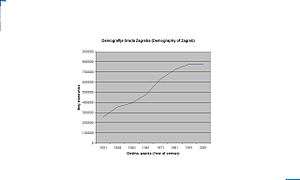Demographics of Zagreb
Zagreb is the largest city in Croatia and the only one whose metropolitan area exceeds one million people. The official population of the city of Zagreb is 790,017 according to the 2011 census. According to the same census, there are 1,088,841 people in the Zagreb metropolitan area including the towns of Samobor, Velika Gorica and Zaprešić.

Overview
According to the local police register department, which bases its information on the number of the applicants who wish to register to vote in Zagreb, in 2005 the city had a population of 973,667.[1]
Most people live in the city proper. The official 2011 census counted 790,017 residents,[2][3][4]
Zagreb metropolitan area population is slightly above 1.2 million inhabitants,[5] as it includes the Zagreb County.[6] In 1997, the City of Zagreb itself was given special County status, separating it from Zagreb County,[7] although it remains the administrative center of both.
The majority of its citizens are Croats making up 92% of the city's population (2001 census). The same census records 60,066 residents belonging to ethnic minorities. Such ethnic minorities comprise: 18,811 Serbs (2.41%), 8,030 Muslims by nationality (1.02%), 6,389 Albanians (0.83%), 6,204 Bosniaks (0.80%), 3,946 Romani (0.55%), 3,225 Slovenes (0.41%), 2,315 Macedonians (0.27%), 2,131 Montenegrins (0.27%), together with other smaller minor ethnic communities, especially the historically present Germans.[8]
Below is the demographic data of Zagreb from the 2011 census.
Ethnicities
Source: Croatian Central Bureau of Statistics, Census 2001[9][10]
| Ethnicity | Number | Percentage |
|---|---|---|
| Croats | 716,344 | 91.94% |
| Serbs | 18,811 | 2.41% |
| Bosniaks | 6,204 | 0.80% |
| Albanians | 3,389 | 0.43% |
| Slovenians | 3,225 | 0.41% |
| Romani | 1,946 | 0.25% |
| Macedonians | 1,315 | 0.17% |
| Montenegrins | 1,313 | 0.17% |
| Hungarians | 841 | 0.11% |
| Czechs | 813 | 0.10% |
| Jews | 368 | 0.05% |
| Ukrainians | 333 | 0.04% |
| Germans | 288 | 0.04% |
| Italians | 277 | 0.04% |
| Russians | 250 | 0.03% |
| Slovaks | 171 | 0.02% |
| Poles | 133 | 0.02% |
| Ruthenians | 123 | 0.02% |
| Bulgarians | 110 | 0.01% |
| Turks | 65 | 0.01% |
| Austrians | 53 | 0.01% |
| Romanians | 37 | 0.00% |
| Vlachs | 1 | 0.00% |
| Non committed | 15,649 | 2.02% |
| Other 1 | 4,764 | 0.61% |
| Unknown | 2,322 | 0.30% |
| Total | 790.017 | 100% |
1 This mode includes, among others:
| Ethnicity | Number | Percentage |
|---|---|---|
| Muslims by nationality | 4,030 | 0.52% |
| Yugoslavs | 36 | 0.00% |
Religions
Source: Croatian Central Bureau of Statistics, Census 2001[11]
| Religion | Number | Percentage |
|---|---|---|
| Roman Catholic | 678,538 | 87.09% |
| Islam | 16,215 | 2.08% |
| Orthodox Church | 15,634 | 2.01% |
| Jehovah's Witness | 1,500 | 0.19% |
| Greek Catholic | 807 | 0.10% |
| Evangelical Church | 569 | 0.07% |
| Adventist Church | 459 | 0.06% |
| Judaism | 323 | 0.04% |
| Baptist Church | 310 | 0.04% |
| Pentecostal Church | 141 | 0.02% |
| Calvinist Church | 42 | 0.01% |
| Old Catholic | 39 | 0.01% |
| Methodist Church | 2 | 0.00% |
| Other religions | 1,393 | 0.18% |
| Agnostic & uncommitted | 31,645 | 4.06% |
| Non-believers | 27,617 | 3.54% |
| Unknown | 3,911 | 0.50% |
| Total | 790.017 | 100% |
References
- "Croatia education market introduction – Education UK Marketing". British Council. February 2008. Archived from the original on 2010-03-09. Retrieved 2010-11-22.
- Zagreb city council (2011). "GRADSKI URED ZA STRATEGIJSKO PLANIRANJE I RAZVOJ GRADA – Odjel za statistiku". www1.zagreb.hr. Retrieved 16 June 2011.
- About Croatia (2011). "About Croatia – Population of Croatia". Information provided by the Croatian Central Bureau of Statistics. Archived from the original on 30 July 2013. Retrieved 16 June 2011.
- "Vital Statistics in 2006". First Release (in Croatian). City of Zagreb, City Institute for Urban Planning, Statistics Department. 2007-10-26. Archived from the original on 2008-09-10. Retrieved 2008-08-29.
- City Mayors & Tann vom Hove (2010). "City Mayors: Largest cities and their mayors in 2011 (Countries A-D)". citymayors.com. Retrieved 29 June 2011.
City Mayors & Tann vom Hove
- Sić, Miroslav (2007). "Spatial and functional changes in recent urban development of Zagreb" (PDF). Delo. Archived from the original (PDF) on 2008-12-17. Retrieved 2008-11-06.
- Narodne novine 62/01, 125/08
- "Population by ethnicity, by towns/municipalities". Census 2001. Croatian Bureau of Statistics. Retrieved 2011-01-20.
- "SAS Output". Dzs.hr. Retrieved 2015-05-20.
- "SAS Output". Dzs.hr. Retrieved 2015-05-20.
- "SAS Output". Dzs.hr. Retrieved 2015-05-20.